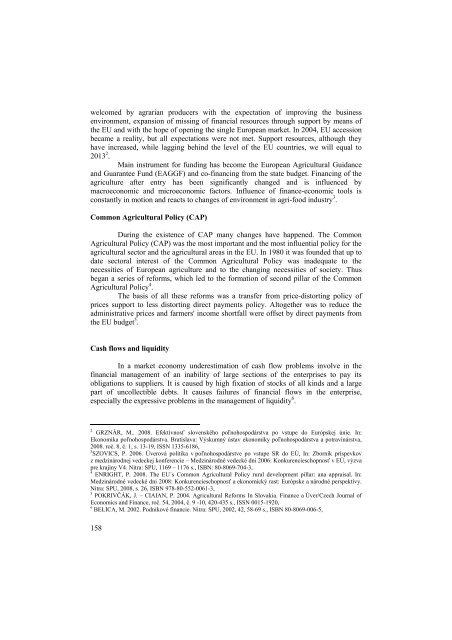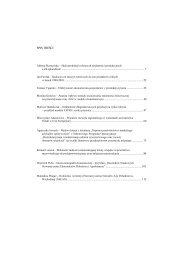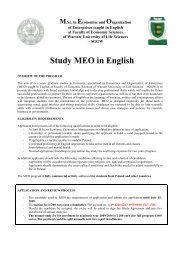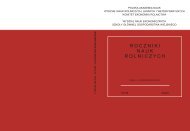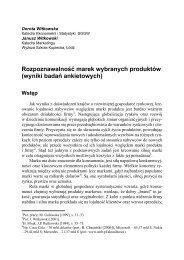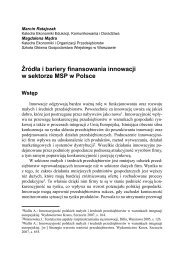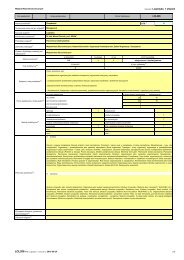pobierz - WydziaÅ Nauk Ekonomicznych SGGW w Warszawie
pobierz - WydziaÅ Nauk Ekonomicznych SGGW w Warszawie
pobierz - WydziaÅ Nauk Ekonomicznych SGGW w Warszawie
Create successful ePaper yourself
Turn your PDF publications into a flip-book with our unique Google optimized e-Paper software.
welcomed by agrarian producers with the expectation of improving the businessenvironment, expansion of missing of financial resources through support by means ofthe EU and with the hope of opening the single European market. In 2004, EU accessionbecame a reality, but all expectations were not met. Support resources, although theyhave increased, while lagging behind the level of the EU countries, we will equal to2013 2 .Main instrument for funding has become the European Agricultural Guidanceand Guarantee Fund (EAGGF) and co-financing from the state budget. Financing of theagriculture after entry has been significantly changed and is influenced bymacroeconomic and microeconomic factors. Influence of finance-economic tools isconstantly in motion and reacts to changes of environment in agri-food industry 3 .Common Agricultural Policy (CAP)During the existence of CAP many changes have happened. The CommonAgricultural Policy (CAP) was the most important and the most influential policy for theagricultural sector and the agricultural areas in the EU. In 1980 it was founded that up todate sectoral interest of the Common Agricultural Policy was inadequate to thenecessities of European agriculture and to the changing necessities of society. Thusbegan a series of reforms, which led to the formation of second pillar of the CommonAgricultural Policy 4 .The basis of all these reforms was a transfer from price-distorting policy ofprices support to less distorting direct payments policy. Altogether was to reduce theadministrative prices and farmers' income shortfall were offset by direct payments fromthe EU budget 5 .Cash flows and liquidityIn a market economy underestimation of cash flow problems involve in thefinancial management of an inability of large sections of the enterprises to pay itsobligations to suppliers. It is caused by high fixation of stocks of all kinds and a largepart of uncollectible debts. It causes failures of financial flows in the enterprise,especially the expressive problems in the management of liquidity 6 .2 GRZNÁR, M.. 2008. Efektívnosť slovenského poľnohospodárstva po vstupe do Európskej únie. In:Ekonomika poľnohospodárstva. Bratislava: Výskumný ústav ekonomiky poľnohospodárstva a potravinárstva,2008. roč. 8, č. 1, s. 13-19, ISSN 1335-6186,3 SZOVICS, P. 2006. Úverová politika v poľnohospodárstve po vstupe SR do EÚ, In: Zborník príspevkovz medzinárodnej vedeckej konferencie – Medzinárodné vedecké dni 2006: Konkurencieschopnosť v EÚ, výzvapre krajiny V4. Nitra: SPU, 1169 – 1176 s., ISBN: 80-8069-704-3,4 ENRIGHT, P. 2008. The EU´s Common Agricultural Policy rural development pillar: ana appraisal. In:Medzinárodné vedecké dni 2008: Konkurencieschopnosť a ekonomický rast: Európske a národné perspektívy.Nitra: SPU, 2008, s. 26, ISBN 978-80-552-0061-3,5 POKRIVČÁK, J. – CIAIAN, P. 2004. Agricultural Reforms In Slovakia. Finance a Úver/Czech Journal ofEconomics and Finance, roč. 54, 2004, č. 9 -10, 420-435 s., ISSN 0015-1920,6 BELICA, M. 2002. Podnikové financie. Nitra: SPU, 2002, 42, 58-69 s., ISBN 80-8069-006-5,158


